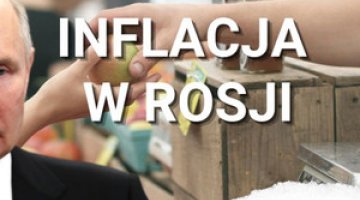Russia is intensifying the global food crisis
The Russian Grain Union (RGU) reported that, from the start of the current agricultural season (1 July 2021) to mid-May, Russia exported 33.85 million tonnes of wheat, which is about 10.4% less than a year ago. Overall, Russian grain exports fell by 17.6% to 38.3 million tonnes in this period (barley exports fell by 33.6% and corn exports by 30%). According to RGU estimates, in the whole season (till 30 June 2022), grain exports could reach 43–45 million tonnes (including 35–36 million tonnes of wheat). To compare, 2020/2021 exports reached 49 million tonnes (including 38.4 million tonnes of wheat). Russia will harvest 121.4 million tonnes of grain in 2021 in comparison to 133.5 million tonnes a year earlier. Its main buyers last season were: Turkey, Iran, Egypt, Saudi Arabia and China.
RGU information also shows that the risk of sanctions imposed on Russia negatively influences the price of its grain on world markets. Russian exporters are forced to sell at a discount – in May this was $25–50 per tonne (6–11% below the cost of European grain) and in March it reached $70 per tonne. Since the beginning of the war, prices have risen significantly: at the beginning of May, Russian wheat (FOB Novorossiysk) cost $396–401 per tonne, while in mid-February this year it was about $260 per tonne.
RGU estimates Russia’s total export potential for the current agricultural season at around 49 million tonnes but, due to the current quotas set by the Russian government (only 8 million tonnes of wheat and 3 million tonnes of other cereals can be exported from 15 February to 30 June 2022) and problems with logistics and contract fees, this level will not be reached. Producers are hoping that they will be able to increase exports at the end of June, with the expiry of the limits, especially as Russia is forecast to have a very good harvest in 2022, estimated at over 130 million tonnes of grain, including around 88.5 million tonnes of wheat. As a result, more than 54 million tonnes of cereals, including over 42 million tonnes of wheat, may be exported in the next agricultural season.
Since the early 2000sy, grain production in Russia has grown dynamically, making the country a net exporter, as well as the world’s largest supplier of wheat. Russia accounts for almost 20% of world wheat exports and about 11% of its production (fourth largest in the world). Supplies from Russia are particularly important for African countries. In 2021, Russia accounted for: about 50% of Eritrea’s wheat imports (the other 50% comes from Ukraine), about 50% of Egypt’s imports (25% from Ukraine) and about 45% of Somalia’s imports (45% from Ukraine).
Commentary
- In recent months, the Kremlin’s policy has led to a destabilisation of the global agri-food market. Russia is blocking the main export routes for Ukrainian grain, and is destroying the agricultural infrastructure and crops. At the same time, Moscow has declared outright that it is ready, among other things, to “engage in overcoming the world food crisis” by increasing grain and mineral fertiliser exports, but in exchange for reduced Western sanctions. Russia denies that it is blocking Ukrainian exports through Black Sea ports, destroying the country’s agricultural infrastructure and exporting grain as the “spoils of war”. The Kremlin says that the main obstacle to Ukrainian grain exports is Kyiv’s attitude, since it is refusing to clear the ports of mines. This is an unreasonable claim since, Russian aggression considered, opening access to ports would create the threat of attack. Moscow’s assurances that it will not use the demined ports for military gain cannot be viewed as credible in the current situation.
- The internal market regulations introduced by the Russian government are increasing uncertainty regarding the volume of Russian exports. The Kremlin has started applying temporary quotas on cereal exports, as well as export duties that limited the volume of supplies abroad as far back as in 2020 – in order to counteract excessive price increases on the internal market. Moreover, in 2022, from March until the end of the agricultural season, the government has banned grain exports to Eurasian Economic Union countries (to limit re-exports of the resource), and is additionally trying to persuade them to introduce grain market regulations similar to those in Russia. According to RGU calculations, the stocks, which will be kept for the next cereal season, are at least 3 million tonnes too high in relation to the needs of the internal market and could be sold abroad. However, the Russian government does not intend to increase the existing export quota.
- Russia’s efforts to destabilise the global food market are aimed at intensifying political and economic pressure on Western countries and Ukraine, and consequently to force the West to make concessions to Moscow. Furthermore, Russia wants to use the crisis it has created to persuade countries in the global south that are dependent on grain imports to support the Russian position. In this context, the Russian government may decide to increase their own grain supplies to these countries. However, it is not in the Kremlin’s interest to significantly increase Ukrainian grain exports.
- The optimistic forecasts for the next grain market season in Russia, based on the already completed sowings, are largely based on the accumulated stocks. In 2022 Russian producers used imported seed. 90% of wheat seed is of domestic origin, but for sunflower seed around 70% is provided by imports, and for maize the figure is around 50%. In addition, Russian agriculture is dependent on imported plant protection products. However, due to the state’s agricultural policy and sanctions, which have restricted the export of fertilisers from the country, Russian producers can benefit from relatively low prices for mineral fertilisers on the internal market.




